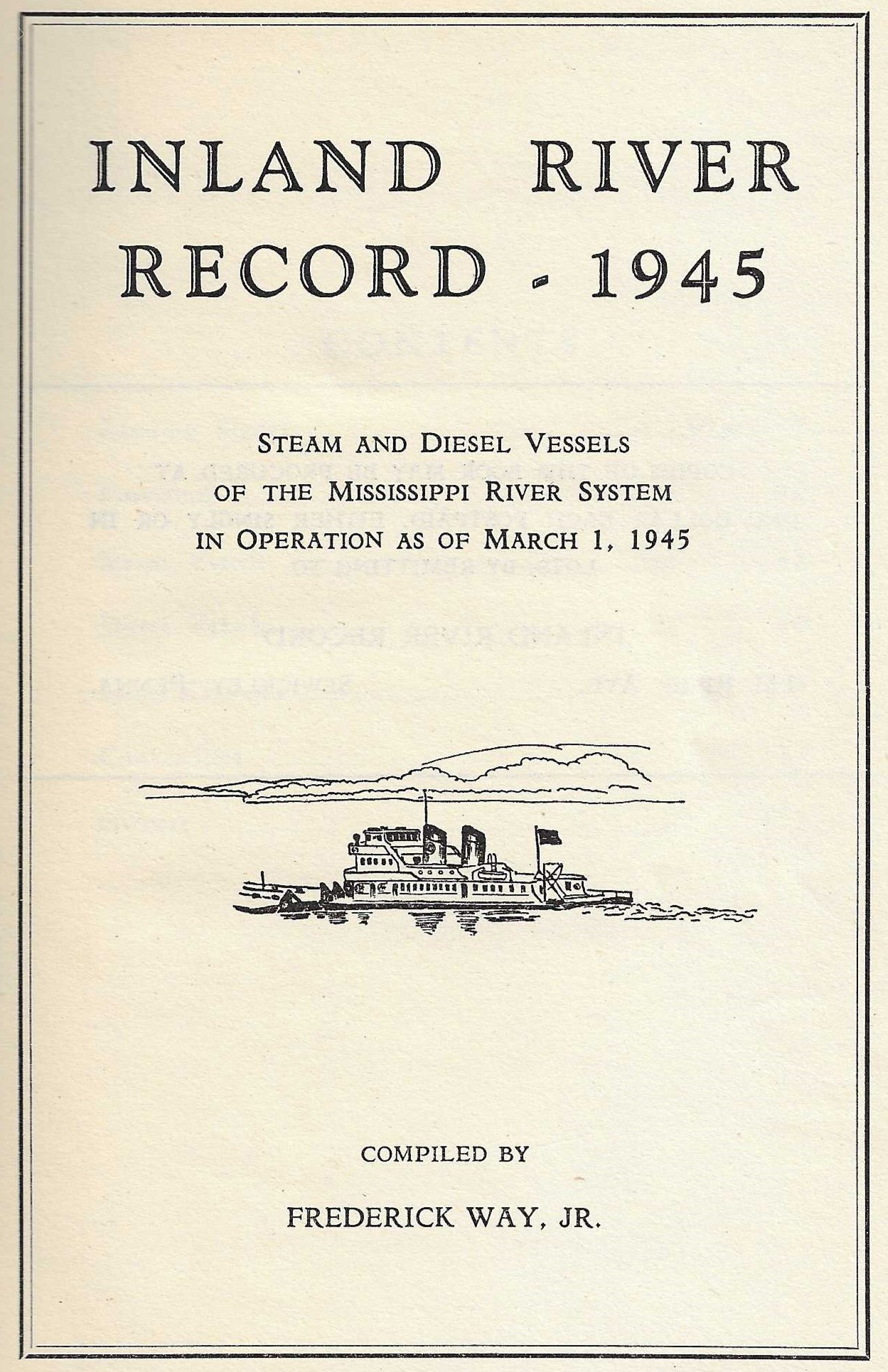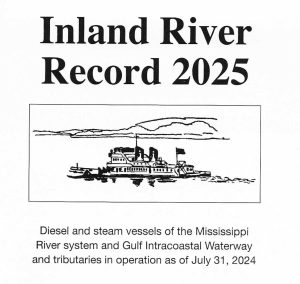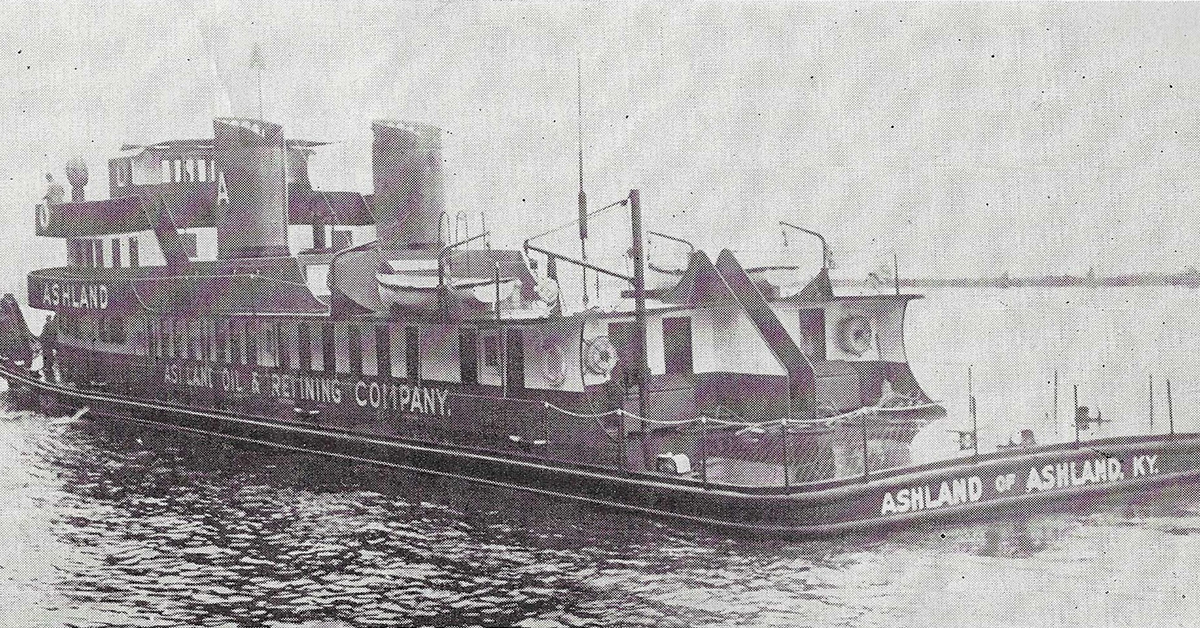While attending and participating in the very enjoyable 2025 IMX in Nashville, I was talking with Zac Metcalf, the associate publisher of The Waterways Journal. We were standing outside the WJ booth inside the exhibition hall. The backdrop had the names of several WJ/Bound Media Group publications superimposed over a map of the inland river system. One of those was for the popular Inland River Record (IRR), a current listing of vessels on the Mississippi River System and Gulf Intracoastal Waterway. Included within the logo for the IRR was the line drawing of a towboat that has graced the title page since the inception of the book in 1945.
I challenged Zac to some “towboat trivia” and asked if he knew what specific boat was depicted in the line drawing. I told him that it was the original Ashland of Ashland Oil & Refining Company (AO&R). Capt. Frederick Way Jr., who created the IRR, had worked aboard the Ashland during World War II. That chapter was described extensively in this column in the January 27 and February 3, 10 and 17 issues of The Waterways Journal. The boat itself was built by Calumet at Chicago in 1941, the first of a three boat order for AO&R.

The May 17, 1941, issue of the WJ had 5 ½ pages dedicated to the new Ashland. A Mr. Henry J. Barbour visited the new boat just before it was ready to leave the builders and wrote a very detailed and glowing description for the WJ. He stated in the first paragraph, “The Ashland not only includes many of the appointments of an ocean-going luxury liner; she sets a new standard in modern towboat design.” He went on to say the vessel included “many unusual features.”
The Ashland, designed by naval architect A.M. Deering of Chicago, was of all-welded steel construction, with a hull that was 145 feet by 31 feet, and was powered by Fairbanks-Morse seven-cylinder model 37E diesels producing 805 hp. each. The boat was equipped with a “triplex Kahlenberg air horn,” which when activated, turned on lights in an electric sign in the form of an “A” affixed to a mast atop the pilothouse. This feature was on every Ashland Oil boat for the next 50 years.
The Ashland moved from the Calumet yard to Lockport, Ill., for final outfitting. A paragraph in the May 17 WJ said Capt. Charles Zubik, president of Zubik Towing Company of Pittsburgh, was a guest aboard for this initial move. The Ashland departed Lockport downbound lite boat on May 10, 1941, with Capt. Fred Howze serving as master-pilot; Capt. W.F. Tucker, pilot; Robert Turner, chief engineer; Richard T. Howze, assistant engineer; Eugene E. Howard, steward (cook); and Stephen Denes, mate. Representatives from Fairbanks-Morse were aboard as well.
Capt. Donald T. Wright, owner/publisher/editor of the WJ, was a guest for the trip from Lockport to St. Louis, as was Andy Franz, advertising manager. Wright had a story about the trip in this same issue and said that M.C. Dupree, transportation manager for AO&R, was aboard as host, and that J.F. Rogan with Calumet Shipyard was also aboard. Joining the boat at Peoria, Ill., was A.L. Mechling, of A.L. Mechling Barge Line, and Pete Riley, former president of the Propeller Club, Port Of Chicago. Wright first referred to Mechling as “A. Leroy Mechling,” and later in the piece as “Roy Mechling.”
The Ashland made the 331-mile trip and arrived at St. Louis, according to Wright, “in 34 hours and 27 minutes.” The vessel landed outside the Goldenrod Showboat, and a reception was held aboard the new boat that evening for invited guests. It departed the next morning for the Ohio River and its home port of Ashland, Ky.
Wright’s article answered a question for this writer. Having only seen black and white photos of the boat when it was new, I was curious about its color scheme. Wright refers to it as being freshly painted in “white and green.” This would change after a few months when the new Paul Blazer was all white with black trim and red stacks.
In 1948, the Ashland underwent a major rebuilding at Dravo Corporation, Neville Island, Pa. The original stern was removed and a new stern with kort nozzles was installed. The dimensions of the boat then measured 152 feet by 31.1 feet. This project also saw the original F-M diesels removed and replaced with a pair of GM (Cleveland) 16-278A engines and Falk reduction gears giving the boat 2500 hp. at 750 rpm. The pilothouse was remodeled with new front windows by Kearfott, and a console with Westinghouse engine controls.
In 1960, it was sold to Harper Towing Company, Catlettsburg, Ky., and renamed Jerry Harper. In March 1961, it was sold to Cavalier Towing Company of Memphis, Tenn. In November 1962, it was renamed Pamela D, and in 1973, it was sold to Drake Towing Company of Metairie, La., when it underwent another extensive rebuilding in New Orleans. This project saw the boat widened by 12 feet to a total width of 43 feet, and the pilothouse was raised significantly. It was also repowered with GM 16-645E2 engines of 3,800 hp. It came out with the new name of Warren and towed under charter to Union Carbide for some time. Throughout, it retained the radio call sign WA 2570.

The vessel was sold in January 1985 to G&C Towing Inc., Point Pleasant, W.Va. In 1991 it was dismantled and sold to a local contractor, who entertained the idea of rebuilding it, but that never materialized and the vessel was finally scrapped. The pilothouse and upper cabin were removed and transported to the Marshall University Inland Waterways Academy above Guyandotte, W.Va., where it was utilized for many years as a fire simulator. Eventually, the steel became brittle and was judged to be unsafe, so that structure was scrapped as well.
Capt. Fred Way spent most of his career on steam packets and excursion boats. Still, Way must have held the Ashland in very high regard for a drawing of it to grace the title page of the IRR when he began it in 1945. He continued to use it in that fashion, and it remained even after the annual publication was sold to The Waterways Journal in 1967. Way remained editor through 1976. Even today, the familiar drawing can be found in each successive edition of the Inland River Record, which for 80 years has been the best way to keep up with the names and owners of vessels working the inland waterways.
Featured image caption: The new Ashland as shown in the May 17, 1941, issue of The Waterways Journal. (From the author’s collection)




